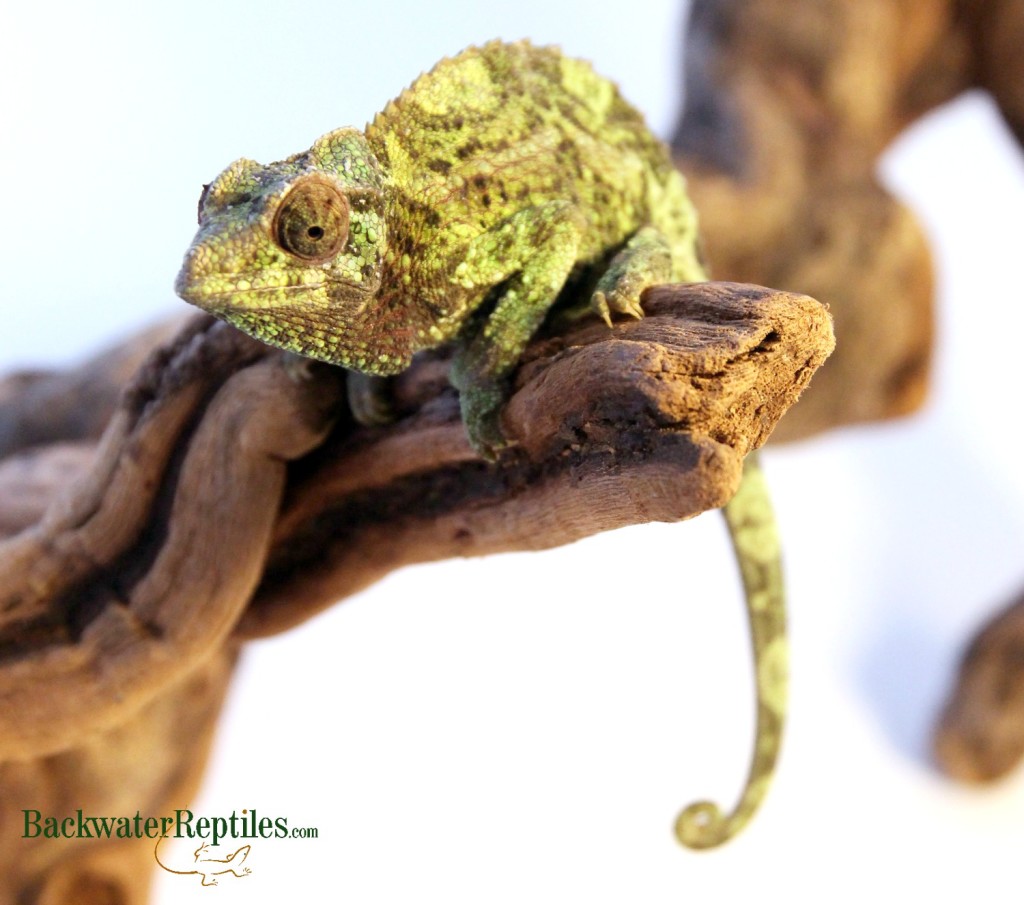Are you thinking about getting your first pet chameleon? One of our top suggestions for you is a great species for beginners – the adorable Jackson’s Chameleon (Chamaeleo jacksonii).
Read on to learn all about Jackson’s chameleon care, based upon our years of successful experience caring for, and breeding, these unique three-horned reptiles. When kept correctly, these chameleons thrive in captivity.
Jackson’s chameleon care
Jackson’s Chameleon Appearance
Many people are attracted to Jackson’s chameleons because of their unique physical appearance. These little chameleons have been said to resemble triceratops because the males have three horns on their head – two above their eyes and one on their nose.
Female Jackson’s don’t have horns, although they do have the potential to give birth to live babies! Unlike most reptiles, female Jackson’s chameleons don’t lay eggs. The sad side effect of this strenuous process is that female Jackson’s actually have considerably shorter lives than the males of the species.

Most male Jackson’s chameleons will grow to be anywhere from eight to ten inches in length. Females are a bit smaller and will only grow to approximately seven or eight inches total length.
Unlike their more colorful cousins such as Panther chameleons, Jackson’s chameleons tend to stay in the brown to green color spectrum. Most will be brown when they are cold or grumpy and they will be green when they are healthy, happy, and well-adjusted. Some Jackson’s will also be shades of yellow, but it’s safe to say your Jackson’s won’t be turning blue, red, or purple, even though chameleons do have the reputation for being able to change color on a whim.
Jackson’s Chameleon Enclosures
The most important element to keeping a chameleon of any species happy is a good environment with the proper lighting, food, and shelter spaces.
All chameleons should have mesh enclosures so that the air is free-flowing and doesn’t get stagnant. The open mesh also helps maintain proper moisture and humidity levels within the cage.
Because Jackson’s chameleons are arboreal, be sure to provide lots of foliage and branches within your chameleon’s enclosure.
A single animal can be housed in a cage that is at least three feet tall, although if you want babies, you can put a male and female together in an enclosure that is about twice that size.

Your Jackson’s chameleon should never (or very rarely) be anywhere on or near the ground of its cage, so no real substrate is required. You can line the cage with paper towels if you desire to make cleaning up feces, dried leaves, and other detritus easier, but it’s not a requirement so long as you spot clean the cage appropriately.
Lighting and temperature are very important for a Jackson’s chameleon. Keep your daytime temperatures around 80 degrees and make sure that the temperature doesn’t drop below 60 degrees at night. You can accomplish this by placing a full spectrum UV light along with a ceramic heat light on one side of the top of the cage. Just be sure that the foliage in your chameleon’s cage is not tall enough that the chameleon can get too close to the lights and burn itself.
Moisture is another extremely important component to keeping your Jackson’s chameleon healthy. You need to provide an automatic drip system or spray the foliage in the chameleon’s cage frequently so that it has a water source to drink from. Chameleons don’t recognize water dishes, so this is an absolute imperative.
Jackson’s Chameleon Feeding
Jackson’s chameleons are insectivores and will thrive on a cricket-based diet. They will also enjoy meal worms, wax worms, reptiworms, and roaches.
It is important that whatever insects you do feed your Jackson’s chameleon have been gut-loaded with the proper nutrients. Healthy insects = healthy chameleon.
Jackson’s Chameleon Temperament
Of all the chameleon species available for sale today, we think that Jackson’s are one of the most calm and laid back as far as personality is concerned.
It’s true that most chameleons do not enjoy being handled, but if you want a chameleon that doesn’t get stressed out by being taken out of its enclosure, a Jackson’s just might be right for you.

Because they are relatively small, they tend to perch nicely on hands and their gripping claws don’t hurt like some of the larger species.
Jackson’s chameleons are also not known for being aggressive towards people. They might change color a bit or puff themselves up to appear larger, but you’d be hard-pressed to make a Jackson’s chameleon bite you.
Jackson’s chameleon care – Conclusion
Whether you’re new to keeping chameleons or very familiar with them, we’ve always had good experiences with Jackson’s chameleons. We would highly recommend these little triceratops chameleons as pets.
Ready for a Jackson’s chameleon of your own? Backwater Reptiles has got you covered! We hope you’ve enjoyed reading our Jackson’s chameleon care sheet.
